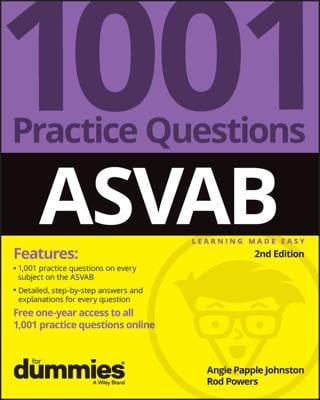When you take the Mechanical Comprehension subtest of the ASVAB, you may not know the correct answer to a question, or you may not know the mechanical principle involved. You may know the mechanical principle but not remember the formula you need to come up with the right answer. Never fear — you can still stumble through this test without totally flaming out.
Using your observations and common sense
Questions on this subtest often include illustrations. The ASVAB test-makers expect you to look at the illustrated device and guess how it operates. When you run across these types of questions, make sure you understand the illustration. Often, parts of the device are labeled. Make certain you read and understand these labels before you try to answer a question about the illustration.
Also, try to use a common-sense approach. You may see the following question:
Which of the following controls an automatic sump pump?
(A) mechanical switch
(B) manual switch
(C) pneumatic valve
(D) float
You may not know the answer to this question, but you can rule out Choice (B), manual switch, because the question asks you about an automatic sump pump, and anything manual isn’t automatic. Eliminating one choice narrows your chances from one in four to one in three. Not a bad start, huh?
A sump pump is used to drain water from an area, and if you know that, you have an even better shot at getting this question right. Think about what type of device detects the presence of water, and you may guess correctly that Choice (D), float, is the right answer.
You can answer a lot of the questions correctly if you just think about what you’ve observed in the world around you. Remember, the Mechanical Comprehension subtest also tests your knowledge of physical principles of the world around you — questions you may expect to find on the General Science subtest. For example, a question may ask something like this:
If all the following objects are the same temperature, which one will feel coldest on a cool day?
(A) a wooden spoon
(B) a plastic spoon
(C) a metal spoon
(D) a fiberglass spoon
You don’t need to know mechanical or scientific principles to know that a metal spoon will feel colder than the other spoons. So it makes sense to select Choice (C) as your answer, even if you can’t explain the science behind this correct answer.
The nerve endings in your skin detect the difference between your inside body temperature and your outside skin temperature. Metal is an excellent conductor of heat, so heat readily flows from your hand into the metal. The heat is conducted rapidly away into the bulk of the metal, leaving your skin surface relatively cool. That’s why metal feels cooler than other, less efficient conductors of heat, such as wood, plastic, or fiberglass.
Using the mathematics of mechanics
Mechanical principles are based on mathematical principles. Therefore, a screw making a complete revolution turns 360 degrees, because a mathematical principle states that 360 degrees are in a circle, a complete revolution. If you have to know the surface area of a floor to determine the pounds per square inch that a ton of tile would put on the floor, that’s a mathematical principle, too.
Suppose you run across this question:
A 3-inch-diameter flanged pipe with six holes is being fitted to a base with six holes. What’s the maximum number of degrees the pipe must be rotated in order to line up the holes?
(A) 120 degrees
(B) 180 degrees
(C) 60 degrees
(D) 360 degrees
This isn’t really a Mechanical Comprehension question at all — it’s a math question. The only part that requires mechanical knowledge is knowing that the holes are spaced equally distant from one another on a flanged pipe. The answer is , Choice (C).
Guessing with a mechanical mind
Like most of the other subtests on the ASVAB, you can and should guess on the Mechanical Comprehension subtest when you don’t know the answer (unless you’re nearing the end of the CAT-ASVAB; too many incorrect answers at the end of a subtest can draw a penalty). Check out these tips to help you narrow the field:
The amount of force needed to move an object (not including friction resistance) is never greater than the weight of the object. Any answer that includes a force that’s greater than the weight of the object being moved is probably wrong.
The correct answer is a mechanical answer. For example, if the question asks, “What’s the purpose of lubricating oil in an engine?” the correct answer won’t be “to make the parts look shiny.” The answer may be “to reduce friction between moving parts.”
Any change in a mechanical operation almost always has pluses and minuses associated with it. So when a question proposes a change, the correct answer is probably the one that specifies the good, the bad, and the ugly. For instance, suppose the question says, “Enlarging the wheel on a hand drill will … ?” The correct answer is the one that says something like “increase the mechanical advantage and decrease the amount of effort needed to operate the drill.”

